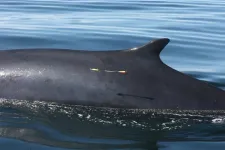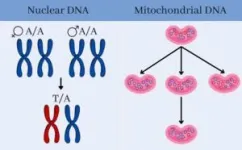(Press-News.org) An international team of marine scientists, led by the University of Groningen in the Netherlands and the Center for Coastal Studies in the USA, has studied the DNA of family groups from four different whale species to estimate their mutation rates. The results revealed much higher mutation rates than previously thought, and which are similar to those of smaller mammals such as humans, apes, and dolphins. Using the newly determined rates, the group found that the number of humpback whales in the North Atlantic before whaling was 86 percent lower than earlier studies suggested. The study is the first proof that this method can be used to estimate mutation rates in wild populations and was published in the journal Science on 1 September.
Mutation rate is a key parameter in genetics and genomics, where it is used to determine rates of evolution and adaptation. It is also used to derive the number of whales in the oceans before they were decimated by large-scale commercial whaling. However, estimating the rate at which new mutations appear in whales, or in any wild species, is difficult.
Pedigree method
For a long time, the phylogenetic method was used to measure mutation rates. This method uses fossil data from different species to estimate when they diverged. Subsequently, DNA from those species is compared to infer how many mutations must have occurred since the divergence. ‘However, the fossil record is not that exact. And some mutations may have disappeared over time,’ says Per Palsbøll, Professor of Marine Evolution and Conservation at the University of Groningen. He has studied whales since the late 1980s and is a corresponding author of the Science paper.
A more recent approach is the pedigree method, which uses the genomes of a pair of parents and their offspring to identify new mutations in the offspring. This more direct method relies on very few assumptions and is ideal for comparing mutation rates among different species, such as whales and humans.
Especially in wild species, the challenge is to obtain tissue samples from both parents and their offspring. First author Marcos Suárez-Menéndez: ‘The method has only been used on a handful of animals that are living in the wild, such as a single wolf pair and their cubs. It has also been used to estimate mutation rates in zoo animals, although it is uncertain if this reflects the mutation rates in the wild where the conditions are very different.’ However, the team, comprising scientists from the Netherlands, USA, Greenland, Denmark, Canada, and the UK, were able to use skin biopsy samples collected from whales during a collaboration that has been ongoing for more than thirty years.
Crossbow
Palsbøll collected his first whale biopsy samples amongst icebergs in the waters off West Greenland in 1988. ‘To do this, we had to sail very close to a whale and then fire a dart with a hollow point using a crossbow.’ The dart punches out a sample and bounces back into the water from where it is collected.
Finding both parents of a whale calf is the first step in measuring the mutation rate using the pedigree method. This is where large-scale DNA analyses come in. Suárez-Menéndez analyzed data that were generated by the other first author, Martine Bérubé, from microsatellite markers in DNA. This DNA was extracted from a large archive of whale biopsy samples and used to create a genetic fingerprint of individuals. ‘I sifted through the microsatellite data to find individuals that were related as mother and calf. Next, I looked for possible fathers in the database.’
In this way, he managed to identify 212 putative parent and offspring trios in four different whale species. The DNA of eight trios was then sent off for genome sequencing. After a final paternity check, Suárez-Menéndez and his colleagues estimated the number of new mutations in the calf and the average mutation rate in whales.
Industrial whaling
The results showed that the mutation rates in whales are similar to the rates seen in pedigrees in smaller mammals such as humans, apes, and dolphins. In contrast, earlier estimates in whales using the phylogenetic method were much lower compared to these smaller mammals. Suárez-Menéndez: ‘And just like in humans, most new mutations originate from the father. So, whales are very similar to us in this respect.’
The team also used a slightly different maternal pedigree method to estimate the mutation rates in DNA from mitochondria, the cell’s power plants. This method has so far only been used in penguins. Mitochondria and their DNA are passed on through the maternal line and Suárez-Menéndez took advantage of four decades of sighting data of humpback cow and calf pairs in the Gulf of Maine, directed by senior author Jooke Robbins at the Center for Coastal Studies. ‘Our study revealed that the mutation rate in whale mitochondrial DNA is also much higher than earlier estimates based on the phylogenetic method,’ explains Suárez-Menéndez.
The newly determined, higher mutation rates were used to infer that the number of whales in the North Atlantic before industrial whaling. The result was 86 percent lower than earlier reported estimates based on phylogenetic mutation rates. ‘Our new mutation rates suggested that some 20,000 humpback whales lived in the North Atlantic before commercial whaling, in contrast to the previous estimate of 150,000,’ says Palsbøll. This is important information, not only for the conservation of whales but also for our understanding of the state of the oceans before whaling. Palsbøll: ‘Another conclusion of wide-ranging consequences is that our study shows that it is entirely feasible to estimate the mutation rate in wild animals.’
Cancer
The human-like mutation rates in whales also led the authors to reject one possible cause of Peto's paradox. This is the observation that, at the species level, the incidence of cancer does not appear to correlate with the number of cells in an organism. Whales have a hundred to a thousand times more cells than, for example, humans, so if they have the same cancer rate as humans, they should get cancer very early in life. Several mechanisms have been proposed for protecting these large sea mammals against cancer. One of those is a slower mutation rate as a consequence of whales having much lower metabolic rates. The discovery that this is not the case, implies that other mechanisms are probably at play in whales, such as an increase in the number of copies of the p53 gene which protects against cancer.
Finally, as the study relied on a large number of tissue samples that have been collected over several decades, the Science paper highlights the importance of long-term ecological research projects. Palsbøll: ‘It is difficult to acquire sustained funding for these kinds of long-term ecological studies. However, we wouldn’t have been able to do this research without the sustained commitment and dedication of the many colleagues who recorded all the sightings and collected the samples that our study relied on.’
Reference: Marcos Suárez-Menéndez, Martine Bérubé, Fabrício Furni, Vania E. Rivera-León, Mads-Peter Heide-Jørgensen, Finn Larsen, Richard Sears, Christian Ramp, Britas Klemens Eriksson, Rampal S. Etienne, Jooke Robbins, and Per J. Palsbøll: Wild pedigrees inform mutation rates and historic abundance in baleen whales. Science, 1 September 2023
END
Mutation rates in whales are much higher than previously reported
Estimate lowers the pre-exploitation number of North Atlantic humpback whales by 86 percent
2023-08-31
ELSE PRESS RELEASES FROM THIS DATE:
Peering into nanofluidic mysteries one photon at a time
2023-08-31
Researchers at University of Manchester and the École polytechnique fédérale de Lausanne (EPFL), Switzerland, have revealed an innovative approach to track individual molecule dynamics within nanofluidic structures, illuminating their response to molecules in ways never before possible.
Nanofluidics, the study of fluids confined within ultra-small spaces, offers insights into the behaviour of liquids on a nanometer scale. However, exploring the movement of individual molecules in such confined environments has been challenging due to the limitations of conventional microscopy techniques. This obstacle prevented ...
Study demonstrates adding complex component of milk to infant formula confers long-term cognitive benefits
2023-08-31
LAWRENCE, KANSAS — Breast milk is widely acknowledged as the most beneficial nutrition for infants, but many families face medical or logistical challenges in breastfeeding. In the U.S., just 45% of infants continue to be exclusively breastfed at 3 months of age, according to the Centers for Disease Control.
For decades, researchers have sought to create a viable complement or alternative to breast milk to give children their best start for healthy development. New research out of the University of Kansas has shown how a complex component of milk that can be added to infant ...
Do artificial roosts help bats? Illinois experts say more research needed
2023-08-31
URBANA, Ill. — Artificial roosts for bats come in many forms — bat boxes, condos, bark mimics, clay roosts, and cinder block structures, to name a few — but a new conservation practice and policy article from researchers at the University of Illinois Urbana-Champaign suggests the structures haven’t been studied rigorously enough and may harm bats in some scenarios. The article, published in Conservation Biology, lays out potential dangers and encourages more research on the popular conservation practice.
“The major emphasis among conservation managers using artificial roosts is how to attract ...
JMIR Dermatology call for papers theme issue on AI and ChatGPT in dermatology
2023-08-31
JMIR Dermatology Editor-in-Chief: Robert Dellavalle, MD, PhD, MSPH and guest editors James A Solomon, MD, PhD, FAAD and Ian Brooks, PhD welcome submissions to a special theme issue examining "Artificial Intelligence (AI) and ChatGPT in Dermatology."
JMIR Dermatology welcomes all topics related to diseases of the skin, hair, and nails, with a wide breadth and depth of papers focusing on AI applications. All topics at the intersection of dermatology, AI, and ChatGPT are eligible for this theme issue.
The journal ...
An ‘introspective’ AI finds diversity improves performance
2023-08-31
An artificial intelligence with the ability to look inward and fine tune its own neural network performs better when it chooses diversity over lack of diversity, a new study finds. The resulting diverse neural networks were particularly effective at solving complex tasks.
“We created a test system with a non-human intelligence, an artificial intelligence (AI), to see if the AI would choose diversity over the lack of diversity and if its choice would improve the performance of the AI,” says William Ditto, professor of physics at North Carolina State University, director ...
Penn State professor to lead field campaign to study climate in Baltimore area
2023-08-31
UNIVERSITY PARK, Pa. — Kenneth Davis, professor of atmospheric and climate science at Penn State, will lead a team of 23 investigators from 13 research institutions in a new field campaign supported by the U.S. Department of Energy (DOE) to study surface-atmosphere interactions around Baltimore, Maryland, to see how they influence the city’s climate. The new campaign, called the Coast-Urban-Rural Atmospheric Gradient Experiment (CoURAGE), is expected to start in October 2024 and run through September 2025.
CoURAGE will contribute to the Baltimore Social-Environmental ...
Covid pandemic may have changed the gut bacteria of infants, research finds
2023-08-31
Infants who spent most of their first year in the pandemic have fewer types of bacteria in their gut than infants born earlier, according to a team of developmental psychology researchers.
The findings, published in Scientific Reports, showed that infants whose gut microbes were sampled during the pandemic had lower alpha diversity of the gut microbiome, meaning that there were fewer species of bacteria in the gut. The infants had a lower abundance of Pasteurellaceae and Haemophilus—bacteria that live within humans and can cause various infections—and significantly different beta diversity, which tells us how similar or dissimilar the gut microbiome for ...
New blood test gives very high accuracy to screen for Alzheimer’s disease
2023-08-31
A new blood test called p-tau217 shows promise as an Alzheimer's disease biomarker, and when used in a two-step workflow very high accuracy to either identify or exclude brain amyloidosis, the most important and earliest pathology. That is an innovation now presented by researchers at the University of Gothenburg, together with colleagues at University of Lund and in Montreal, Canada.
In recent years, a lot of effort has been put on developing biomarkers in blood that could potentially help to identify Alzheimer’s disease (AD). Tau protein, ...
Antioxidants stimulate blood flow in tumors
2023-08-31
Vitamin C and other antioxidants stimulate the formation of new blood vessels in lung cancer tumours, a new study from Karolinska Institutet published in The Journal of Clinical Investigation shows. The discovery corroborates the idea that dietary supplements containing antioxidants can accelerate tumour growth and metastasis.
“We’ve found that antioxidants activate a mechanism that causes cancer tumours to form new blood vessels, which is surprising, since it was previously thought that antioxidants have a protective effect,” says study leader Martin Bergö, professor at the ...
Talk therapy with other moms an effective treatment for postpartum depression, McMaster research shows
2023-08-31
HAMILTON, ON (Aug. 31, 2023) – An innovative model of care that offers new mothers psychotherapy delivered by other mothers who have also experienced post-partum depression (PPD) should be implemented in clinical practice, according to researchers at McMaster University.
Researchers worked with nearly 200 mothers over a year and a half, during the height of the COVID-19 pandemic, and found those receiving treatment from their peers were 11 times more likely to experience remission of their major depressive disorder. The findings of the randomized control trial are published in Acta Psychiatrica Scandinavica.
PPD and its associated symptoms affect ...
LAST 30 PRESS RELEASES:
Therapies that target specific type of cell death may be an effective avenue for cancer treatment, UTHealth Houston researchers find
CHEST releases guideline on biologic management in severe asthma
Scientists create a system for tracking underwater blackouts
Fruit fly pigmentation guides discovery of genes that control brain dopamine and sleep
World's largest physics conference to be held in Denver and online this March
New mega-analysis reveals why memory declines with age
Understanding ammonia energy’s tradeoffs around the world
UTHealth Houston researchers map gene disruptions in sporadic early onset Alzheimer’s disease across key brain regions
Minimum wage increases are linked to safer pregnancies
Left in the cold: Study finds most renters shut out of energy-saving upgrades
This crystal sings back: Illinois collaboration sheds light on magnetochiral instability
Organisms in the Atacama Desert soil are remarkably diverse
Children’s Hospital Colorado research outlines first pediatric classifications for suicide risk in adolescents and kids
No thyme wasted: Harnessing the medicinal benefits of thyme extract With small doses
Fat surrounding the colon interacts with the immune system
Genetic predisposition to excess body weight and survival in women diagnosed with breast cancer
New mechanism links Epstein-Barr virus to MS
Genetic risk factor and viral infection jointly contribute to MS
When a virus releases the immune brake: New evidence on the onset of multiple sclerosis
Wyss Institute-led collaboration awarded by ARPA-H PRINT program to engineer off-the-shelf, universal, transplant-ready graft for liver failure
Research on the behavioral mechanisms of rural distributed photovoltaic development: A view of prosumer perspective
More surgical patients are on opioid use disorder medications — hospitals must modernize pain care
New study reveals strategic logic behind global patent litigation venue selection
An abnormally slow heart rate is associated with xylazine-fentanyl overdose; primarily seen in northeastern United States
The path to solar weather forecasts
Inflammation and mitochondrial dysfunction in cirrhotic cardiomyopathy: therapeutic implications
The Great Bear Rainforest nature writing retreat
Research reveals hidden diversity of E. coli driving diabetic foot infections
Breakthrough in parallel Cartesian grid generation: Dynamic partition weight strategy resolves load imbalance
ESMT Berlin study shows how startups can communicate to win over silent audiences online
[Press-News.org] Mutation rates in whales are much higher than previously reportedEstimate lowers the pre-exploitation number of North Atlantic humpback whales by 86 percent






